Color
These three tabs give you complete control over the color, thickness and opacity of lines. They enable you to create any type of line effect, from simple lines that fade out to complex brush effects. Each tab works in a similar way:
- Set the general color, thickness and opacity using the Color, Thickness and Opacity settings at the top of the tabs.
- Modify the color, thickness and opacity using the modifier options. To switch on a modifier, enable its option. You will see its settings appear in the bottom part of the tab, where you can adjust them.
Use this setting to define the common color.
Use this setting to define overall brightness.
With a few exceptions, each tab has the same modifier options. For example, the Along Stroke modifier is present on all three tabs.
![]() Modifiers
Modifiers
Distance
Position
Scale
Illumination
Texture
From Surface
Texture Map
Screen Texture
Along Stroke
Total Length
Facing Angle
Join Angle
Screen Angle
From Line
Python
Noise
Activate the desired modifier here:
![]() Python
Python
The Python modifier lets you create virtually any medium or style, from a simple pencil to a complex brush, using the powerful Python programming language.
The Blend setting defines which blend mode is used to mix the gradient with the main color: Add, Subtract or Multiply. If you want the result to be the same color as the gradient, set the main color to black and the Blend mode to Add.
This is the strength of the modifier’s effect, from 0% (no effect) to 100% (full effect).
Enter your Python script into the Script field.
Enter a script into the Script box or click the Expression Editor button and enter the script into Cinema 4D’s Python script editor.
This acts as a quick reference to look up the names of the commands. It has no other purpose. It does not insert commands.
Position along a line in pixels (screen space).
normalized position along a line (0 to 1).
Distance to the line from the current render point (which is within the line’s thickness). Values range from - Thickness to 0 to Thickness.
The line’s thickness as set on the [Thickness] tab.
The total length of the stroke being rendered.
The render point in screen space (with Z).
The offset (0 to 1) along the line segment being rendered.
The world coordinates for the point being rendered.
Current document time in seconds.
Current frame.
Frames per second.
The screen space coordinates for the start of the line (LineOff = 0 at the LineStart, 1 at LineEnd).
Screen space for line segment’s end point.
Join angle to the line segment at LineStart (if available, or 0.0).
Join angle (0 to 2*pi) to the line segment at LineEnd.
The line normal in screen space (2D, Z=0).
The normal from the edge that created the original line segment.
The line segment’s position along the stroke in pixels (A means LineStart, B LineEnd).
The position along the stroke in screen space for the line segment being rendered.
The index number of the object point or spline point that created the start of the line segment (or -1 if not available).
The point index that created the LineEnd (or -1).
The polygon index that created the line segment (or -1 if not available, like a spline).
The polygon index that shared the edge (or -1 if not available).
This passes in the raybits from the Cinema 4D render. See the Cinema 4D SDK.
The angle between the ray and normal on the surface.
The normal from the surface (if PolyHit is not 0, which says it hit an object).
Bumped surface normal.
Distance to the point hit on the surface (if one was hit).
Really only useful to know if an object was hit by a ray, which means the value is not 0.
World position for the ray’s starting point.
Direction of the ray (the ray is from Cinema 4D).
The world coordinates for the point hit (if one was hit).
The render image left pixel.
Render top pixel (left, top usually 0, but not always, e.g render region).
Right pixel (width = right-left+1)..
Bottom pixel (height = bottom - top +1).
Object’s left screen bounds pixel. This is for the object that the line came from. This is not necessarily the object hit by the Cinema 4D ray.
Object’s top screen bounds pixel.
Object’s right screen bounds pixel.
Object’s bottom screen bounds pixel.
The color set in the [Color] tab (Color parameter only).
![]() Distance
Distance
 Original, Color, Thickness, Opacity, All three
Original, Color, Thickness, Opacity, All threeThe Distance modifier modifies the color, thickness or opacity based on distance from the camera.
This is the strength of the modifier’s effect, from 0% (no effect) to 100% (full effect).
The Range setting defines the range over which the color, thickness or opacity is modified.
This range is from the part of the object nearest the camera to the part furthest away.
This uses the camera’s Front Blur End and Rear Blur End values (Depth tab) when you enable them. If the options are disabled then Sketch and Toon will use the Target Distance in place of Rear Blur End and the Camera in place of Front Blur End.
When you select the Custom range, you will see the Min and Max boxes appear. These define the start and end of the range as distances from the camera.
For details on using gradients, see here.

The Blend setting defines which blend mode is used to mix the gradient with the main color: Add, Subtract or Multiply. If you want the result to be the same color as the gradient, set the main color to black and the Blend mode to Add.

With Color set to black and Mode set to Add, the gradient’s colors are applied directly to the line.
 Control the shading using a gradient.
Control the shading using a gradient.See Range.
See Range.
![]() Position
Position
 Original, Color, Thickness, Opacity, All three
Original, Color, Thickness, Opacity, All threeThe Position modifier modifies the color, thickness or opacity based on the object’s position along the camera’s X, Y or Z axis.
This is the strength of the modifier’s effect, from 0% (no effect) to 100% (full effect).
The Axis is which camera axis to use. The Min and Max values define range over which the parameter is modified. For example, if Axis is set to Z and Min and Max are set to 500 m and 1000 m respectively, the range is from 500 m to 1000 m along the camera’s Z axis.

The Blend setting defines which blend mode is used to mix the gradient with the main color: Add, Subtract or Multiply. If you want the result to be the same color as the gradient, set the main color to black and the Blend mode to Add.

With Color set to black and Mode set to Add, the gradient’s colors are applied directly to the line.
See Axis.
See Axis.
 Control the shading using a gradient.
Control the shading using a gradient.![]() Scale
Scale
The Scale modifier modifies the color, thickness or opacity based on the object’s scale along an axis.
 Original, Color, Thickness, Opacity, All three
Original, Color, Thickness, Opacity, All threeThis modifier is based on the scale — not the size — of the objects!
For details on using gradients, see your Cinema 4D reference manual.

The Blend setting defines which blend mode is used to mix the gradient with the main color: Add, Subtract or Multiply. If you want the result to be the same color as the gradient, set the main color to black and the Blend mode to Add.

With Color set to black and Mode set to Add, the gradient’s colors are applied directly to the line.
This is the strength of the modifier’s effect, from 0% (no effect) to 100% (full effect).
The Axis setting is which axis to use: X, Y or Z.
The Coordinates setting lets you choose whether this axis is an object axis (Local) or world axis (World). For example, if you set Axis to Y and Coordinates to Local, the lines will be modified based on the scale of the object’s Y axis.
Use the Min and Max settings to define a color range for the Color tab
This is the area over which the setting will be modified. If the area is set to Size the range will be from 0 to 1. To define an area manually, select Manual and define the area accordingly.
See Min.
 Control the shading using a gradient.
Control the shading using a gradient.![]() Along Stroke
Along Stroke
 Original, Color, Thickness, Opacity, all three.
Original, Color, Thickness, Opacity, all three.This is the strength of the modifier’s effect, from 0% (no effect) to 100% (full effect).
The Range setting is the range over which the color, thickness or opacity is modified.
This range is from the start to end of each stroke (or line segment if strokes are disabled).
The Custom mode lets you specify the start and end of the range (Min and Max) along the stroke in pixels and the number of times the range is looped (Loop).

The Blend setting defines which blend mode is used to mix the gradient with the main color: Add, Subtract or Multiply. If you want the result to be the same color as the gradient, set the main color to black and the Blend mode to Add.

With Color set to black and Mode set to Add, the gradient’s colors are applied directly to the line.
See Range.
See Range.
Defines how often a given line should be repeated.
 Control the shading using a gradient.
Control the shading using a gradient.![]() Facing Angle
Facing Angle
 Original, Color, Thickness, Opacity, All three
Original, Color, Thickness, Opacity, All threeThe Facing Angle modifier modifies the color, thickness or opacity based on the direction in which the lines are facing relative to the camera. Hidden lines are also affected if shown.
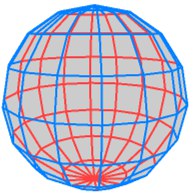 Blue visible lines and red hidden lines via the Facing Angle modifier.
Blue visible lines and red hidden lines via the Facing Angle modifier.For details on using gradients, see your Cinema 4D reference manual.

The Blend setting defines which blend mode is used to mix the gradient with the main color: Add, Subtract or Multiply. If you want the result to be the same color as the gradient, set the main color to black and the Blend mode to Add.

With Color set to black and Mode set to Add, the gradient’s colors are applied directly to the line.
This is the strength of the modifier’s effect, from 0% (no effect) to 100% (full effect).
 Control the shading using a gradient.
Control the shading using a gradient.![]() Total Length
Total Length
These define the minimum and maximum line length in pixels over which the parameter is modified.
 Original, Color, Thickness, Opacity, All three
Original, Color, Thickness, Opacity, All threeThe Total Length modifier modifiers the color, thickness or opacity based on the length of each stroke (or line segment if strokes are disabled).
For details on using gradients, see your Cinema 4D reference manual.

The Blend setting defines which blend mode is used to mix the gradient with the main color: Add, Subtract or Multiply. If you want the result to be the same color as the gradient, set the main color to black and the Blend mode to Add.

With Color set to black and Mode set to Add, the gradient’s colors are applied directly to the line.
This is the strength of the modifier’s effect, from 0% (no effect) to 100% (full effect).
Use this setting to define the minimum line length (in pixels) over which the setting should be modified.
Use this setting to define the maximum line length (in pixels) over which the setting should be modified.
 Control the shading using a gradient.
Control the shading using a gradient.![]() Join Angle
Join Angle
 Original, Color, Thickness, Opacity, All three
Original, Color, Thickness, Opacity, All threeThe Join Angle modifier modifies the color, thickness or opacity based on the angle of the joints in the stroke.
For details on using gradients, see your Cinema 4D reference manual.

The Blend setting defines which blend mode is used to mix the gradient with the main color: Add, Subtract or Multiply. If you want the result to be the same color as the gradient, set the main color to black and the Blend mode to Add.

With Color set to black and Mode set to Add, the gradient’s colors are applied directly to the line.
This is the strength of the modifier’s effect, from 0% (no effect) to 100% (full effect).
The Ends mode controls what happens at the ends of the stroke.
The very start and end of the stroke use the parameter’s full value. For example, if you are using the Join Angle modifier on the Thickness tab and Thickness is set to 12 pixels, the start and end of the stroke will be 12 pixels thick.
Minimum Angle
Zero Angle
Maximum Angle
Depending on which of these modes you select, the ends are treated as if they are joints of the minimum or maximum angle or of zero angle.
 Control the shading using a gradient.
Control the shading using a gradient.![]() Screen Angle
Screen Angle
 Original, Color, Thickness, Opacity, All three
Original, Color, Thickness, Opacity, All threeThe Screen Angle modifier modifies the color, thickness or opacity based on the line’s direction on the computer screen.
For details on using gradients, see your Cinema 4D reference manual.

The Blend setting defines which blend mode is used to mix the gradient with the main color: Add, Subtract or Multiply. If you want the result to be the same color as the gradient, set the main color to black and the Blend mode to Add.

With Color set to black and Mode set to Add, the gradient’s colors are applied directly to the line.
This is the strength of the modifier’s effect, from 0% (no effect) to 100% (full effect).
 Control the shading using a gradient.
Control the shading using a gradient.The Rotate setting lets you rotate the modifier’s effect.
![]() From Line
From Line
 Original, Color, Opacity, Color + Opacity
Original, Color, Opacity, Color + OpacityThe From Line modifier modifies the color or opacity based on distance from the line’s edge.
For details on using gradients, see your Cinema 4D reference manual.

The Blend setting defines which blend mode is used to mix the gradient with the main color: Add, Subtract or Multiply. If you want the result to be the same color as the gradient, set the main color to black and the Blend mode to Add.

With Color set to black and Mode set to Add, the gradient’s colors are applied directly to the line.
This is the strength of the modifier’s effect, from 0% (no effect) to 100% (full effect).
 Control the shading using a gradient.
Control the shading using a gradient.![]() Illumination
Illumination
 Original lighting, Color, Thickness, Opacity, All three
Original lighting, Color, Thickness, Opacity, All threeThe Illumination modifier modifies the color, thickness or opacity based on the illumination falling onto the line.
On the Color tab you can use the modifier in two modes: Intensity and Color.
For details on using gradients, see your Cinema 4D reference manual.

The Blend setting defines which blend mode is used to mix the gradient with the main color: Add, Subtract or Multiply. If you want the result to be the same color as the gradient, set the main color to black and the Blend mode to Add.

With Color set to black and Mode set to Add, the gradient’s colors are applied directly to the line.
This is the strength of the modifier’s effect, from 0% (no effect) to 100% (full effect).
This mode ignores the gradient and gives you grayscale lines whose brightness depends on the intensity of light falling onto the line. Use the Brightness value to darken or brighten the effect.
The Color mode uses the gradient’s colors. See the example above.
See Mode.
 Control the shading using a gradient.
Control the shading using a gradient.Normally, all lights in a scene will be taken into account. Use the include or exclude modes in the light box to use only selected lights.
Use Lighting to choose whether the lighting, shadows or both are used to modify the parameter.
This inverts the modifier’s effect.
Here you can choose which lights are used for the illumination. All lights in the scene are used by default. To include or exclude specific lights, set Mode to Include or Exclude and Drag & drop the lights into the Lights box.
![]() Texture
Texture
With the exception of the Python modifier, this is the most powerful modifier in Sketch and Toon. It offers considerable control over the rendering of the lines and enables you to create countless brush effects.
Making a brush with the Texture modifier
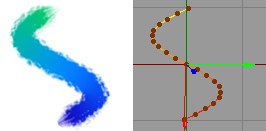 Figure 1.
Figure 1.- Start a new scene and draw a spline similar to the one above.
- In the Material Manager, choose Create / Materials / New Sketch Material.
- In the render settings, on the Effects tab, select the Sketch material and on its Lines tab, enable the Splines option.
- In the Material Manager, double-click the Sketch material to display its settings in the Material Editor.
- On the Thickness tab, set Thickness to, say, 30 pixels. On the Color tab, enable the Along Stroke option and define a gradient.
 Figure 2.
Figure 2.- Render to check the progress of the line (Figure 3, left line).
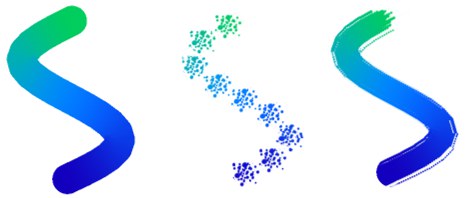 Figure 3.
Figure 3.- On the Opacity tab, enable the Texture option and in the Texture settings that appear, click the Texture triangle and choose Load Image. Use the dialog that opens to load the chalk_chunky.jpg texture from Cinema 4D’s library/pattern location.
- Set Spacing to 8% to form a continuous line of tiles (Figure 3, right line).
- The stroke looks too uniform. For a more natural effect, set the Variation value for Size to 20% and the Variation value for Angle to 10%. This varies the size and direction of the tiles (Figure 4, left line).
 Figure 4.
Figure 4.For finishing touches, try fading out the thickness and opacity at the ends of the stroke using the Along Stroke modifier on the Thickness and Opacity tabs (Figure 4, right line).

The Blend setting defines which blend mode is used to mix the gradient with the main color: Add, Subtract or Multiply. If you want the result to be the same color as the gradient, set the main color to black and the Blend mode to Add.

With Color set to black and Mode set to Add, the gradient’s colors are applied directly to the line.
This is the strength of the modifier’s effect, from 0% (no effect) to 100% (full effect).
These buttons enable you to load and save the Texture settings for brush-style presets.
These buttons enable you to load and save the Texture settings for brush-style presets.
 Texture & alpha, Original line, Texture, Texture & Alpha
Texture & alpha, Original line, Texture, Texture & AlphaHere you can choose the main texture and apply an alpha to it.
The alpha is available on the Color tab only. Use a normal image for the alpha, not an alpha channel.
Use this setting to offset scale and texturing in the U direction.
Use this setting to offset scale and texturing in the V direction.
These values offset and scale the texturing in the U and V directions.
These values offset and scale the texturing in the U and V directions.
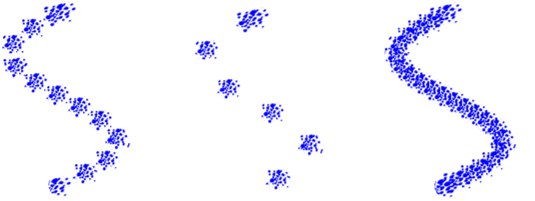 From left to right: Spacing set to 100%, 200% and 50%.
From left to right: Spacing set to 100%, 200% and 50%.The default Spacing value of 100% places one texture tile directly after another. Use a higher or lower value to move the tiles apart or overlap them.
 Original, Scatter U, Scatter V, Scatter U & V, Count = 8
Original, Scatter U, Scatter V, Scatter U & V, Count = 8The Scatter values scatter the tiles in the U and V directions. 0% means no variation, 100% means maximum variation.
The Scatter values scatter the tiles in the U and V directions. 0% means no variation, 100% means maximum variation.
To mix in extra tiles, increase the Count value. For example, change the Count value from 1 to 3 for three times as many tiles.
Parts of the texture that are not on the line will be cut off. See the middle line below.
See Scatter U, Scatter V, Count.
Varies the count value.
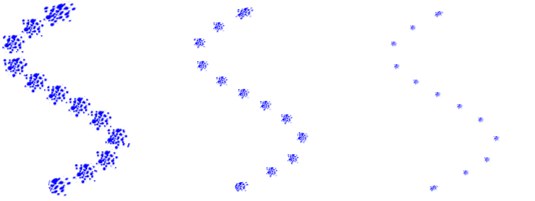 From left to right: Size set to 100%, 50% and 25%.
From left to right: Size set to 100%, 50% and 25%.The Size controls the scale of the tiles. The Variation value lets you vary the size of each tile from 0% (no variation) to 100% (maximum variation).
See Size.
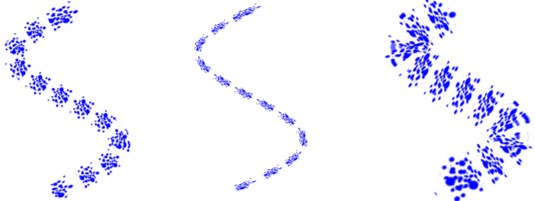 From left to right: Roundness set to 100%, 35% and 200%.
From left to right: Roundness set to 100%, 35% and 200%.The Roundness value squashes (less than 100%) or stretches (greater than 100%) the tiles in the line’s U direction. The Variation value varies the roundness of each tile from 0% (no variation) to 100% (maximum variation).
See Roundness.
This value rotates each tile.
The Variation value varies the angle of each tile from 0% (no variation) to 100% (maximum variation).
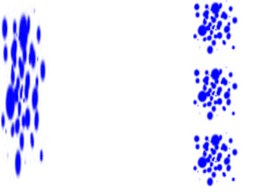 Aspect disabled (left) and enabled (right).
Aspect disabled (left) and enabled (right).If the Aspect option is disabled, the texture tile is stretched to fit the whole line. Enable the option to use the texture’s width to height ratio instead.
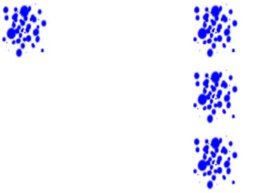 Tile disabled (left) and enabled (right).
Tile disabled (left) and enabled (right).To tile the texture, enable the Tile option and ensure the Aspect option is disabled.
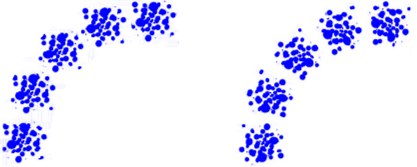 Bend disabled (left) and enabled (right).
Bend disabled (left) and enabled (right).Enable the Bend option if you want the tiles rotate to follow the direction of the line.
![]() From Surface
From Surface
 Original, Normal lines, From Surface enabled
Original, Normal lines, From Surface enabledThe From Surface modifier modifies the color of the line based on the color of the surface.
For details on using gradients, see your Cinema 4D reference manual.

The Blend setting defines which blend mode is used to mix the gradient with the main color: Add, Subtract or Multiply. If you want the result to be the same color as the gradient, set the main color to black and the Blend mode to Add.

With Color set to black and Mode set to Add, the gradient’s colors are applied directly to the line.
This is the strength of the modifier’s effect, from 0% (no effect) to 100% (full effect).
 33%, 66%, 100%
33%, 66%, 100%This controls the brightness of the lines as a percentage of the color sampled from the surface. In other words, the higher you set this value, the brighter the lines and the more they blend in with the image.
These options control whether illumination and shadows are included when the surface is sampled.
Note that this and the next option only work if the Sketch and Toon render settings’ Object setting is set to Off.
Use this setting to determine whether or not shadows should be included when using a surface to define a color.
![]() Texture Map
Texture Map
 The texture, Color, Thickness, Opacity, All three
The texture, Color, Thickness, Opacity, All threeThe Texture Map modifier modifies the color, thickness or opacity based on a texture map.
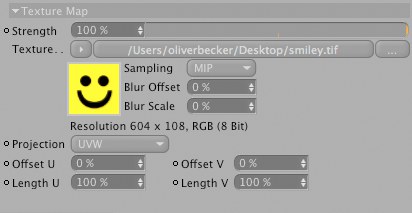 Color tab.
Color tab.For details on using gradients, see your Cinema 4D reference manual.

The Blend setting defines which blend mode is used to mix the gradient with the main color: Add, Subtract or Multiply. If you want the result to be the same color as the gradient, set the main color to black and the Blend mode to Add.

With Color set to black and Mode set to Add, the gradient’s colors are applied directly to the line.
This is the strength of the modifier’s effect, from 0% (no effect) to 100% (full effect).
This is the texture used to modify the lines.
This is the projection to use for the texture map, such as UVW, Flat or Spherical.
Use this setting to offset scale and texturing in the U direction.
Use this setting to offset scale and texturing in the V direction.
Use this setting to offset scale and texturing in the U direction.
Use this setting to offset scale and texturing in the V direction.
![]() Screen Texture
Screen Texture
 The texture, Color, Thickness, Opacity, All three
The texture, Color, Thickness, Opacity, All threeThe Screen Texture modifier modifies the color, thickness or opacity based on a texture map placed over the entire rendered image (the screen). If the object covers only part of the screen, it will receive only part of the texture.
For details on using gradients, see your Cinema 4D reference manual.

The Blend setting defines which blend mode is used to mix the gradient with the main color: Add, Subtract or Multiply. If you want the result to be the same color as the gradient, set the main color to black and the Blend mode to Add.

With Color set to black and Mode set to Add, the gradient’s colors are applied directly to the line.
This is the strength of the modifier’s effect, from 0% (no effect) to 100% (full effect).
Here you can choose the screen texture.
Use this setting to offset the text origin along the x axis on the screen.
Use this setting to offset the text origin along the Y axis on the screen.
Use this setting to offset scale and texturing in the X direction.
Use this setting to offset scale and texturing in the Y direction.
![]() Noise
Noise
 Original, Color, Thickness, Opacity, All three
Original, Color, Thickness, Opacity, All threeThe Noise modifier modifies the color, thickness or opacity based on a noise pattern.
This is the strength of the modifier’s effect, from 0% (no effect) to 100% (full effect).
Choose from 30 types of noise such as Blistered Turbulence, Dents and Wavy Turbulence. These are the same types that are available for Cinema 4D’s Noise shader.
The Mapping drop-down list controls which coordinates are used to generate the noise. This can affect how the noise looks, how it changes as the object or camera moves and whether the noise is continuous over line segments if strokes are disabled.
 Strokes disabled (left) and enabled (right).
Strokes disabled (left) and enabled (right).The position along the line is used. Avoid using this type if strokes are disabled, otherwise poor results are likely (see left cylinder above).
The noise is calculated in the space of the screen. The noise will change is the object’s position on the screen changes.
The noise is calculated in object space and remains the same regardless of object and camera moves.
The noise is calculated in world coordinates. The noise remains the same if you move the camera but changes if you move the object.
The Mode setting defines whether the noise uses the RGB color system or the HSV color system to modify the color. The three boxes below the Mode setting define how strongly the noise affects each color component (R,G and B or H, S and V depending on the mode).
See Mode.
See Mode.
See Mode.
See Mode.
See Mode.
See Mode.
The rate at which the noise animates, in cycles per second.
The octaves of detail in the noise.
The Scale value is the global size of the noise, the Scale X and Scale Y values are the relative scale of the noise in the X and Y directions.
See Scale.
See Scale.
Used for antialiasing. In general, leave the value set to the default of 100% but if the line texture flickers when you animate, try increasing the value. Or if you are rendering a high-res still and you want crisp detail, set the value lower.
The Low Clip value controls the bottom clipping value of the noise; all values below Low Clip will be clipped to zero.
The High Clip value controls the top clipping value of the noise; all values above High Clip will be clipped to 100%.
These settings control the overall brightness and contrast of the noise. Values above zero increase brightness or contrast, values below zero decrease brightness or contrast.
See Brightness.
If this option is enabled, the noise is absolute, causing it to fold about its midpoint.
Enable this option to invert the effect.